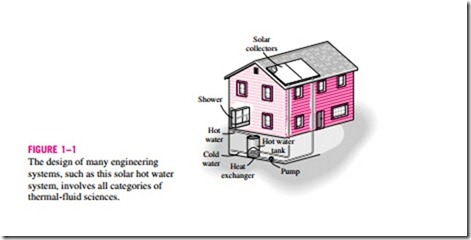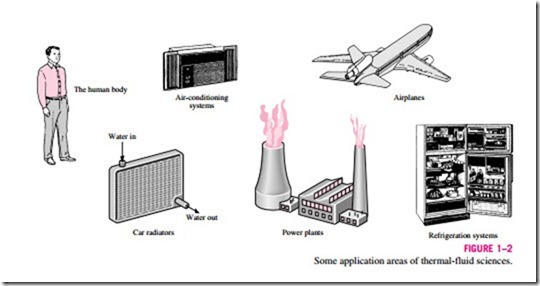Many engineering systems involve the transfer, transport, and conversion of energy, and the sciences that deal with these subjects are broadly referred to as thermal-fluid sciences. Thermal-fluid sciences are usually studied under the subcategories of thermodynamics, heat transfer, and fluid mechanics. We start this chapter with an overview of these sciences, and give some historical background. Then we review the unit systems that will be used and dimensional homogeneity. This is followed by a discussion of how engineers solve problems, the importance of modeling, and the proper place of software packages. We then present an intuitive systematic problem- solving technique that can be used as a model in solving engineering problems. Finally, we discuss accuracy, precision, and significant digits in engineering measurements and calculations.
INTRODUCTION TO THERMAL-FLUID SCIENCES
The word thermal stems from the Greek word therme, which means heat. Therefore, thermal sciences can loosely be defined as the sciences that deal with heat. The recognition of different forms of energy and its transformations has forced this definition to be broadened. Today, the physical sciences that deal with energy and the transfer, transport, and conversion of energy are usually referred to as thermal-fluid sciences or just thermal sciences. Traditionally, the thermal-fluid sciences are studied under the subcategories of thermodynamics, heat transfer, and fluid mechanics. In this book we present the basic principles of these sciences, and apply them to situations that the engineers are likely to encounter in their practice.
The design and analysis of most thermal systems such as power plants, automotive engines, and refrigerators involve all categories of thermal-fluid sciences as well as other sciences (Fig. 1–1). For example, designing the radiator of a car involves the determination of the amount of energy transfer from a knowledge of the properties of the coolant using thermodynamics, the determination of the size and shape of the inner tubes and the outer fins using heat transfer, and the determination of the size and type of the water pump using fluid mechanics. Of course the determination of the materials and the thick- ness of the tubes requires the use of material science as well as strength of materials. The reason for studying different sciences separately is simply to facilitate learning without being overwhelmed. Once the basic principles are mastered, they can then be synthesized by solving comprehensive real-world practical problems. But first we will present an overview of thermal-fluid sciences.
Application Areas of Thermal-Fluid Sciences
All activities in nature involve some interaction between energy and matter; thus it is hard to imagine an area that does not relate to thermal-fluid sciences in some manner. Therefore, developing a good understanding of basic principles of thermal-fluid sciences has long been an essential part of engineering education.
Thermal-fluid sciences are commonly encountered in many engineering systems and other aspects of life, and one does not need to go very far to see some application areas of them. In fact, one does not need to go anywhere. The heart is constantly pumping blood to all parts of the human body, vari- ous energy conversions occur in trillions of body cells, and the body heat generated is constantly rejected to the environment. The human comfort is closely tied to the rate of this metabolic heat rejection. We try to control this heat transfer rate by adjusting our clothing to the environmental conditions. Also, any defects in the heart and the circulatory system is a major cause for alarm.
Other applications of thermal sciences are right where one lives. An ordinary house is, in some respects, an exhibition hall filled with wonders of thermal-fluid sciences. Many ordinary household utensils and appliances are designed, in whole or in part, by using the principles of thermal-fluid sci- ences. Some examples include the electric or gas range, the heating and air- conditioning systems, the refrigerator, the humidifier, the pressure cooker, the water heater, the shower, the iron, the plumbing and sprinkling systems, and even the computer, the TV, and the DVD player. On a larger scale, thermal-fluid sciences play a major part in the design and analysis of automo- tive engines, rockets, jet engines, and conventional or nuclear power plants, solar collectors, the transportation of water, crude oil, and natural gas, the wa- ter distribution systems in cities, and the design of vehicles from ordinary cars to airplanes (Fig. 1–2). The energy-efficient home that you may be living in, for example, is designed on the basis of minimizing heat loss in winter and heat gain in summer. The size, location, and the power input of the fan of your computer is also selected after a thermodynamic, heat transfer, and fluid flow analysis of the computer.

